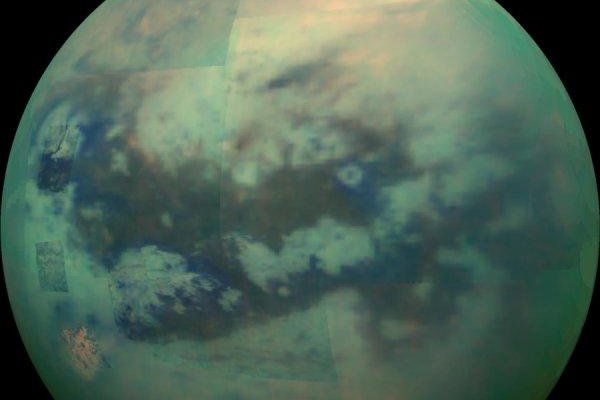New research suggests Titan, Saturn's largest moon, features electrically charged sand grains. Photo by NASA/JPL
March 27 (UPI) -- New research suggests the sand grains on Titan, Saturn's largest moon, behave similar to the packing peanuts used in shipping boxes.
Lab experiments suggest the granules become electrically charged and clump together, resisting motion as they attach themselves to other hydrocarbons.
The sand grains become charged as they're excited by strong winds and hop along the surface -- a phenomenon known as saltation.
Researchers believe the electrically bound granular clumps can maintain their charge for weeks or even months.
"If you grabbed piles of grains and built a sand castle on Titan, it would perhaps stay together for weeks due to their electrostatic properties," Josef Dufek, a professor of geophysics at the Georgia Institute of Technology, said in a news release. "Any spacecraft that lands in regions of granular material on Titan is going to have a tough time staying clean. Think of putting a cat in a box of packing peanuts."
The unusual behavior of Titan's sand grains may explain the moon's unique dune patterns. Massive sand dunes on Titan appear to form in the direction opposite the moon's prevailing east-to-west winds.
Scientists suggest the electrical bonds among sand grains is too strong to be disturbed by prevailing winds. Only strong winds are likely to influence dune formation on Titan's surface.
Researchers believe much of Titan's sand consists of naphthalene and biphenyl. In the lab, scientists put grains of the two toxic compounds in a modified pressure vessel and rotated the grains in a dry, pure nitrogen environment for 20 minutes. Afterwards, researchers measured the electric properties of the granules.
"All of the particles charged well, and about 2 to 5 percent didn't come out of the tumbler," said researcher Méndez Harper. "They clung to the inside and stuck together. When we did the same experiment with sand and volcanic ash using Earth-like conditions, all of it came out. Nothing stuck."
The findings -- detailed in the journal Nature Geoscience -- are a reminder that drawing geophysical parallels between Earth and alien worlds can be problematic.
"Titan's extreme physical environment requires scientists to think differently about what we've learned of Earth's granular dynamics," concluded Dufek. "Landforms are influenced by forces that aren't intuitive to us because those forces aren't so important on Earth. Titan is a strange, electrostatically sticky world."















